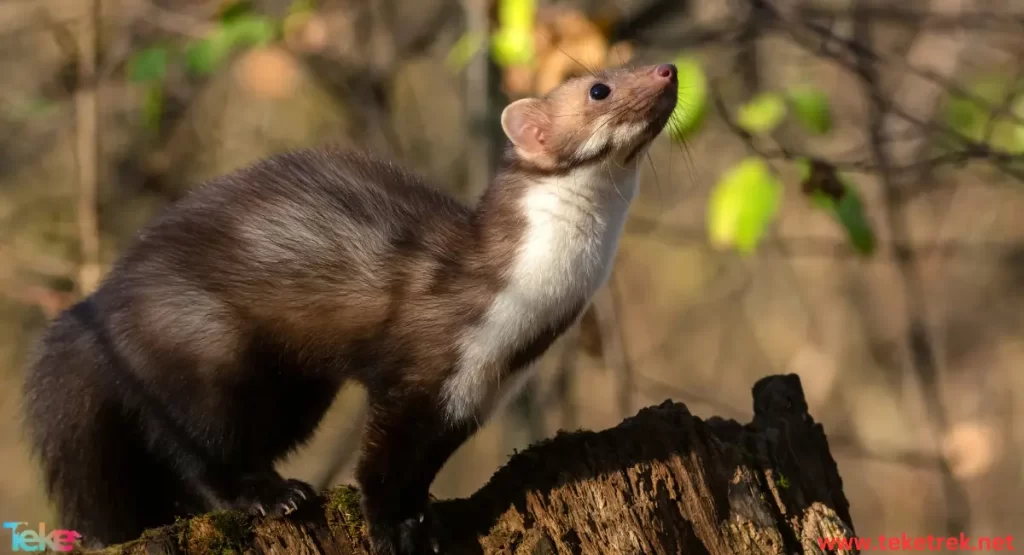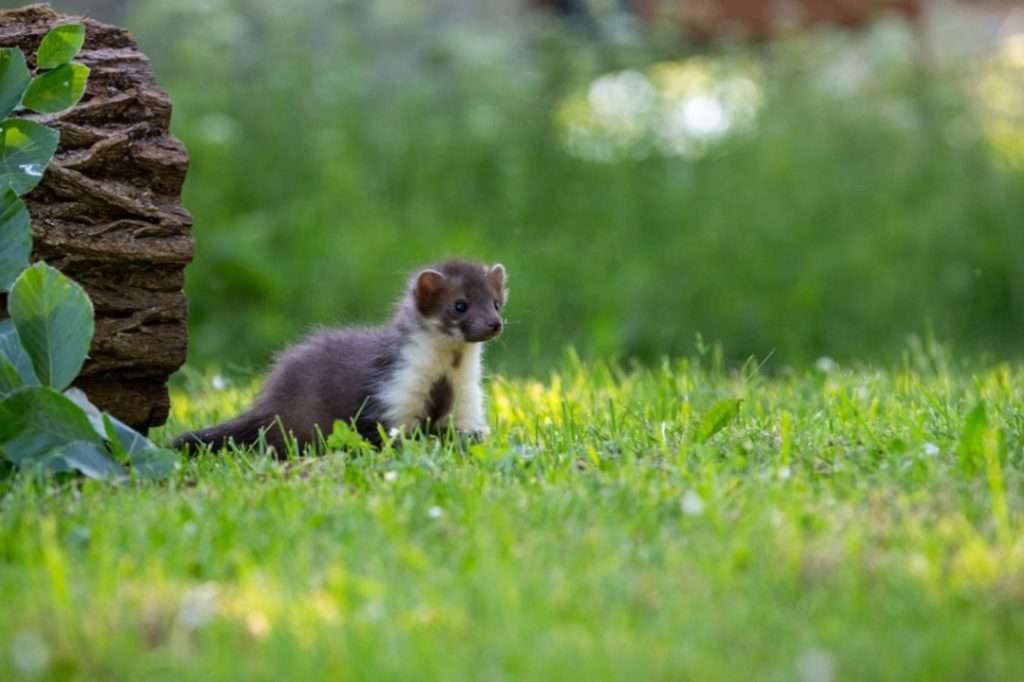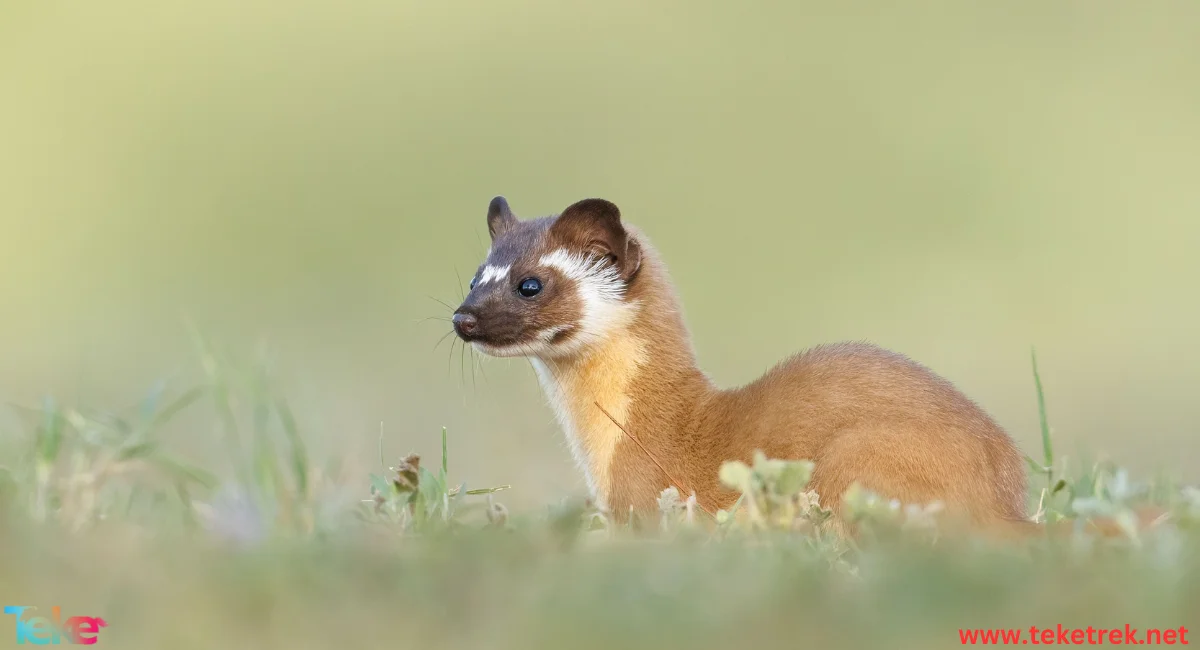Weird Facts About Weasels: There’s no doubt that everyone has heard of the famous animal, the weasel, in many countries around the world. It’s a creature of curiosity and wonder. At first glance, it appears to be a cute and lovable animal. However, in reality, it’s a cunning, deceptive, predatory creature thirsty for blood. Let’s get to know this creature up close and learn on TekeTrek about its prominent characteristics.
Facts about Weasels
Scientific Name: Mustela
- The weasel is a mammal belonging to the family Mustelidae or the Mustelids.
- It’s one of the smallest predators and one of the most beautiful in the natural world.
- It’s characterized by a small, flat head and a long, slender cylindrical body.
- The weasel can curl its body for warmth. It can transform into a ball inside its burrow.
- It has a long, flexible neck, short limbs, and a slender tail. Its short feet end with sharp claws that help it elegantly and swiftly pursue its prey.
- As for its beauty, its body is covered with dense short fur adorned with various colors of brown, white, and yellow, giving it a charm and beauty unmatched in the natural world.
- Its beauty is incomplete without mentioning its efficient digestive system, which includes the mouth, esophagus, stomach, and intestines, helping it digest food easily and smoothly.
- It has a lower jaw consisting of a single bone containing 34 teeth.
- The length of a male weasel can reach up to 22 cm, with its tail measuring 6.5 cm.
- The length of a female weasel is 18 cm, with her tail measuring 4.5 cm. The average weight is about 198 grams.
- The weasel has amazing climbing abilities. It can climb trees well to reach bird nests and target the eggs and chicks inside them, executing this movement with skill, safety, and precision.
- It’s considered a skilled opportunistic hunter, with increased movement and activity at night, taking advantage of darkness to roam and search for hunting opportunities. During the day, the weasel tends to stay in its burrows and underground dens, remaining hidden and fortified to avoid danger and seek refuge from harsh environmental factors.

Facts about the Weasel
- It has a cute face but is bloodthirsty.
- It traps its prey, grabs it, wraps its body around it to immobilize it, and then delivers a deadly bite to the back of its head.
- It can adapt to seasons by changing the color of its fur. In summer, it becomes brown, and in winter, it turns white.
- The sound of the weasel is light and cannot be heard.
- It moves on the ground with stealth to hunt its prey. It jumps from place to place and suddenly stops to check the surrounding areas.
- The weasel can spray a thick liquid in the face of its prey, emitting a pungent odor.
- Despite its small size, the weasel has astonishing speed, enabling it to escape from predators quickly and efficiently.
- The weasel has exceptional night vision, being able to see objects clearly and accurately in pitch darkness thanks to its large and sophisticated eyes.
Weasel’s Diet: what do weasels eat?
- The weasel is a skilled hunter, relying on its agile body to chase down prey.
- It kills its prey by delivering a sharp bite to the back of the neck.
- Rats make up 60-80% of its diet.
- It is adept at hunting mammals, insects, reptiles, birds, and rabbits.
- It also consumes fish, amphibians, snakes, crustaceans, and mollusks, and preys on poultry and eggs.
- The weasel needs to consume food equivalent to a quarter or a third of its body weight daily.
- It can travel up to 2 kilometers in a single night in search of prey.
- The weasel is known to strike the neck of its prey and continue biting until it dies.
- It possesses an excellent sense of smell, which it uses to locate food.
- The weasel hides surplus food in caches near its den.
- Some animals prey on the weasel, including owls, hawks, eagles, foxes, snakes, cats, and dogs.
Weasel’s Habitat
- Its presence is closely linked to the availability of its favorite prey. It typically lives in burrows and in colder climates.
- It inhabits forests, agricultural lands, meadows, fields, pastures, and plains.
- It is found along the banks of water bodies and avoids deep forests and sandy deserts.
- It lives in tree hollows and among woodpiles.
- It is distributed in Britain, Europe, Africa, Asia, North America, and New Zealand.
- The average lifespan of female weasels is 3 years. However, males have a much shorter lifespan due to their constant roaming, which exposes them to risks.

Weasel Reproduction
- Female weasels typically mate once per breeding season and give birth to 4-6 offspring.
- In years abundant with rodents, females may breed twice.
- The newborns feed on their mother’s milk for up to 4 weeks.
- The breeding season for weasel’s spans from April to August.
- Males and females live in separate territories, with the size of these territories varying depending on the availability of food.
Benefits and Drawbacks of Weasels
- One of its most significant benefits lies in its role in controlling harmful rodents, offering humans relief from these pests.
- Drawbacks: Weasels are considered dangerous to residents because they prey on poultry and eggs, often entering poultry enclosures through holes. They can transmit diseases to poultry, such as tularemia, canine distemper, and Aleutian disease.
- They can cause damage to household properties and furniture if they enter residential areas.
- Weasels generally avoid humans, but if threatened, they defend themselves using their sharp teeth.
What eats weasels
Several predators feed on weasels, including larger carnivores such as foxes, coyotes, and birds of prey like owls and hawks. Additionally, larger snakes and domestic cats may also prey on weasels. Despite their agility and cunning, weasels face predation from various species as part of the natural food chain.
Weasel Behavior
The weasel exhibits unique behaviors that distinguish it from other mammals in the wild. It displays aggressive behavior towards any intruders in its habitat. Some of its most notable behaviors are as follows:
- The weasel tends to be aggressive towards everyone. It has a long tail, fast legs, and is a skilled climber. The weasel hunts its prey by smelling or hearing its scent.
- The weasel feeds on meat, hunting for (rodents, birds, rabbits, poultry, small newborn animals, insects, and reptiles).
Weasel’s Adaptation to the Environment
The weasel is capable of quickly adapting to its surrounding environment. It inhabits ecological habitats that include fertile agricultural lands, grassy areas, and the following specific environmental features:
- The weasel lives in natural habitats covered by trees and grass. It prefers fertile agricultural lands, grassy fields, lowlands, wetlands, riverbanks, around swamps, gardens, and poultry farms.
- It is difficult for the weasel to live on high plateaus or near mountainous areas, and it is rarely found in dense forests due to the scarcity of its preferred prey.
Weasel Communication
The weasel has a cunning strategy that enables it to communicate with others or escape from enemies quickly. The weasel executes the following:
- When threatened, the weasel emits a foul-smelling liquid to escape from its enemies.
- The weasel lives alone, not in groups, and builds its burrows under tree trunks and rocks.
- The weasel searches for food every day, even during the winter.
Natural Enemies of the Weasel
Despite being a predator, the weasel has many natural enemies. Its list of major predators includes:
- Predatory animals such as bears, foxes, tigers, and lions.
- Birds of prey, including hawks, eagles, and owls.
Interaction Between Humans and the Weasel
It is well-known that humans and the weasel do not share a friendly relationship. The weasel is considered a harmful and undesirable animal due to several reasons, which are as follows:
- Humans often view the weasel as a nuisance because it preys on poultry and rabbits, animals that are raised by people. As a result, the weasel has been persecuted by humans for thousands of years.
- However, the weasel provides a beneficial service to humans by hunting rodents, reptiles, insects, and eliminating them completely.
Unique Abilities of the Weasel
The weasel possesses several unique and crafty abilities that allow it to skillfully hunt its prey and escape from its enemies. Some of its notable abilities include:
- The weasel can run and sprint at high speeds while hunting small prey. It can cover a distance of 2.5 km during its hunt.
- The weasel consumes a quarter of its body weight in food daily to stay alive, relying on its small size to seek out food.
- The weasel is most active at dawn, running through tunnels, burrows, and fields in search of suitable food.
How the Weasel Uses Its Strong Senses for Hunting
The weasel relies on certain physical traits for hunting and escaping. It uses its strong senses in hunting with high skill. Here are its characteristics:
- The weasel has a strong sense of smell and sharp eyesight, allowing it to navigate and hunt prey with great speed.
- It has small feet that enable it to run, dive, and climb trees very quickly.
The Impact of the Weasel on the Ecosystem
The weasel plays an important role in maintaining the ecological balance, much like other animals. Its life cycle depends on being both a predator and prey for other animals. Its role is as follows:
- The weasel helps maintain the ecological balance by relying on rodents, reptiles, and insects as its main food sources. Thus, the weasel protects humans from these harmful and nuisance creatures, keeping the environment clean.
- The weasel also protects humans from diseases and epidemics caused by the overpopulation of rodents and cockroaches in urban areas.
- It serves as prey for other predators and birds of prey, which contributes to maintaining the ecological equilibrium.
The Weasel and Extinction
The weasel faces many hunting and killing attempts, which threaten its existence over the years, potentially leading to extinction. Consequently, no other animal will perform its environmental role if it disappears. Here’s the relationship between the weasel and potential permanent extinction:
- The weasel belongs to the mammalian class and is part of the Mustelidae family.
- It is found in Asia, North America, Europe, and Africa.
- The weasel is characterized by its slim body, short legs, and dense fur.
- It plays a significant role in protecting the environment from harmful living creatures.
- Despite this, it is considered a harmful mammal by humans due to its tendency to steal birds from farms and feed on them.
- The weasel faces the risk of extinction in some regions due to overhunting by hunters and farmers trying to protect their livestock.
Myths and Superstitions About the Weasel
The weasel has been subject to numerous stories, myths, and superstitions throughout history, many of which have been fueled by poverty and ignorance. People have often associated the weasel with social conditions. Some of the most notable myths about the weasel are:
- An incorrect belief among Egyptians, especially the elderly, is that capturing a weasel without killing it, placing it in a large jar, sealing it tightly, and then burying the jar underground under the house, will bring good fortune and wealth to the household for life.
- Another superstition involves the weasel eating poultry and chicks. It is believed that killing a weasel and burying it near the home will cause a large quantity of gold to emerge from the ground, equivalent to the amount of poultry it consumed.
Types of Weasels
- Mountain Weasel: Lives in high-altitude mountainous areas and prefers living in the burrows of its prey after consuming them. Found in India, Tibet, the Himalayas, and various parts of Asia.
- Amazon Weasel: The largest species of weasel in South America, reaching up to 50.8 cm in length. Prefers to live deep in the Amazon near rivers.
- Colombian Weasel: Extremely rare in South America.
- Japanese Weasel: Classified as an endangered species. Prefers living in highlands, forests, and areas near water.
- Long-tailed Weasel: Characterized by its long tail, which makes up 40-70% of its body length. Found throughout South and North America.
- Yellow-bellied Weasel: Recognizable by its dark yellow belly fur, different from the rest of its body color. Lives in Asia and plays a role in maintaining ecological balance by preying on small rodents and mammals.
- Indonesian Mountain Weasel: Endangered species found in Indonesia on the islands of Java and Sumatra.
- Least Weasel: One of the smallest weasel species, with completely white fur. Distributed across various parts of the Northern Hemisphere.
- Back-striped Weasel: Known for its hiding skills, with two stripes—one silver from its head to the base of its tail, and the other yellow from its chest to its belly. Found in Asia.
- Egyptian Weasel: Can coexist with humans and is found in the outskirts of Egyptian villages and cities. Consumes garbage and rodents.
- European Polecat: Not as agile as other species, with a shorter body and stronger jaws. Brown or dark brown in color. Preys on rodents, frogs, and birds.
- Black-footed Ferret: Extinct species also known as the American dog hunter. Hunts prairie dogs and inhabits areas in Arizona, Wyoming, and Dakota. Recognizable by its black feet, face, tail, and ears.
- European Mink: Primarily found in France, Spain, and Eastern Europe.
- Masked Palm Civet: Named for its fur-covered face resembling a mask, with dark eyes. Found throughout Eastern and Central Europe.
- Ermine: A common species throughout North America and Eurasia.
FAQ About the Weasel
- Is a ferret a weasel?
The weasel and the mongoose are classified as mammals and the order of carnivores, but they differ in family, as the weasel belongs to the weasel family, while the mongoose belongs to the marten family. Although the weasel and mongoose may look similar, the mongoose belongs to the cat-like carnivores. The weasel follows dog-like carnivores
- Is a weasel a pet?
Weasels are not usually a pet, but rather a wild animal that lives in the wild and is very solitary and reserved in nature. They cannot be tamed as easily as some other pets and are often feral and will act wild if they feel threatened or stressed.
- Is the weasel a predator?
Yes, weasels are predators. It feeds on a variety of prey, including small mammals such as mice and rabbits, birds, insects, and reptiles. They use their intelligence and flexibility to hunt and are often able to adapt to different environments to obtain food.
- Do weasels catch rats?
Yes, weasels are skilled predators that hunt a variety of small mammals, including rats. Rats are among the prey species targeted by weasels, especially in areas where both species coexist. Weasels play a valuable role in controlling rodent populations in their natural habitats.
- What are weasels famous for?
Weasels are famous for their agility, cunning hunting techniques, and their ability to control rodent populations by preying on small mammals like mice and voles. They are also known for their slender bodies, quick movements, and elusive nature. Additionally, weasels have been featured in folklore and literature as symbols of cunning and stealth.
- Why is a person called a weasel?
The “weasel” takes its name from the idea that it appears at social events and weddings, as speculation suggests.
- Are weasels friendly to humans?
Yes, weasels are friendly to humans, it is not dangerous.


In conclusion, the aggressive nature of weasels has given them a bad reputation among humans. It should be noted that encountering a weasel, despite its cute appearance, is not always fortunate. Caution should be exercised, as it can quickly turn into a greedy and hostile animal.
Sources
aliefuk.com
Wikipedia and websites






